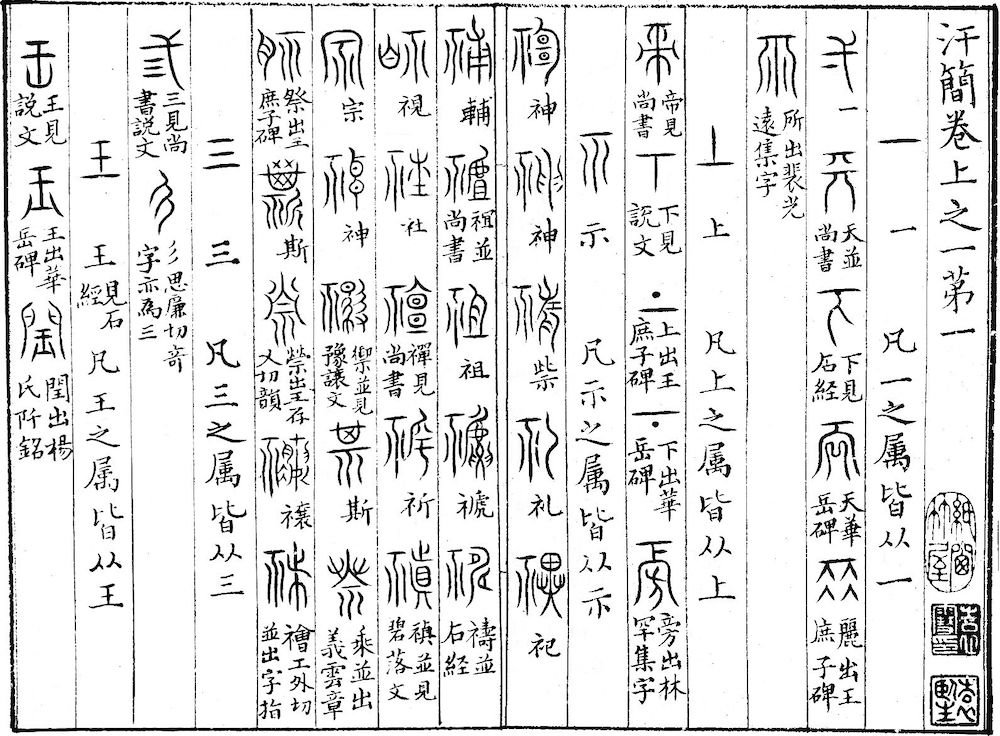Hanjian 汗簡 is a specialized glossary of ancient characters (guwen 古文) compiled by the scholar Guo Zhongshu 郭忠恕 (d. 977), courtesy name Shuxian 恕先 or Guobao 國寶.
Guo hailed from Luoyang 洛陽 (modern Luoyang, Henan) and served the Later Han 後漢 (947-950) and Later Zhou 後周 (951-960) dynasties, the last two of the Five Dynasties 五代 (907-960), as an erudite (boshi 博士) of the National University (taixue 太學). Under the newly founded Song dynasty 宋 (960-1279) he became a recorder (zhubu 主簿) in the Directorate of Education (guozijian 國子監). In 977 he was exiled to Dengzhou 登州, but died en route in Qizhou 齊州.
Guo was a good calligrapher and painter and was famous for his expertise in lexicography (xiaoxue 小學). Apart from the Hanjian, Guo Zhongshu also wrote the glossary Peixi 佩觿.
The name of the book Hanjian means "bamboo slips from the Han period 漢 (206 BCE-220 CE)", the character Han 漢 being replaced by 汗 (actually "sweat") because it was the name of the dynasty which Guo Zhongshu served and thus had to be avoided. In some texts therefore, the book title is written 漢簡.
 |
Beginning of the Hanjian , Sibu congkan xubian 四部叢刊續編 edition, reproducing a manuscript by Feng Jicang 馮己蒼 (Feng Shu 馮舒, 1593-1645) from the collection of the family Qu 瞿氏 from Chengshu 常熟, Jiansu. |
In early Song-period book catalogues like Chongwen zongmu 崇文總目, Junzhai dushu zhi 郡齋讀書志 and Zhizhai shulu jieti 直齋書錄解題, the Hanjian is not listed. The first catalogue mentioning it is the bibliographic chapter Yiwen zhi 藝文志 (ch. 202-209) in the official dynastic history Songshi 宋史, where it is called Hanjianji 汗簡集, with a length of 7 juan.
For the transmitted, 3-juan long glossary Hanjian, Guo Zhongshu used old-text Classics like Guwen Shangshu 古文尚書 (see Shangshu 尚書 "Book of Documents"), Gu Zhouyi 古周易 (see Yijing 易經 "Book of Changes") or Gu Zhouli 古周禮 (see Zhouli 周禮 "Rites of the Zhou") as well as old inscriptions on stone steles, which makes a total list of 71 sources (listed in the book's Yinyong shu mulu 引用書目録).
The author arranged the characters discussed according to the radical system of the Han-period dictionary Shuowen jiezi 說文解字. Each character is first presented in its ancient form, than transposed into the modern standard script (kaiti 楷體), commented on concerning pronunciation (fanqie system 反切) and the literary source.
Guo's glossary is of scholarly importance because he used texts the greatest part of which was lost already during the 18th century, when the imperial series Siku quanshu 四庫全書 was compiled. Today, only three of the seventy-odd sources Guo used survive. Moreover, the transmitted versions do not correspond in all instances to the wording of Guo's quotation. For many ages therefore, the Hanjian had served as an important handbook on ancient characters.
Modern studies demonstrate that the shape of characters as recorded by Guo Zhongshu deviate from those found on oracle bone inscriptions or bronze inscriptions, but fits well with the shape of characters used during the Warring States period 戰國 (5th cent.-221 BCE) as found, for instance, in the multi-shape recordings of the Stone Classics (e.g. Santi shijing 三體石經), on bamboo slips, silk, seals, or coins.
Qian Daxin 錢大昕 (1728-1804) brought forward the argument that Guo had too much relied on other secondary texts instead of "going to the roots", i.e. carrying out original research.
Apart from the Siku quanshu edition, the Hanjian was printed by Wang Qishu 汪啟淑 and Wang Liming 汪立名 (Yiyucaotang Studio 一隅草堂 from 1703) and is included in the series Sibu congkan xubian 四部叢刊續編. There is also a manuscript edition preserved in the Library Haiyuange 海源閣 of Yang Yizeng 楊以增 (1787-1856).
Zheng Zhen 鄭珍 (1806-1864) wrote the 8-juan long commentary Hanjian jianzheng 汗簡箋正. It is published together with Guo's Hanjian in the series Guangya shuju congshu 廣雅書局叢書. Zheng supported the critique of Qian Daxin, but argued that during the Song period, most scholars did not discern between the original lemmata of the Shuowen jiezi and the supplementary characters that the brothers Xu Xuan 徐鉉 (916-991) and Xu Kai 徐鍇 (920-974) had added as a kind of appendix to each radical section (xinfu 新附). Guo Zhongshu likewise was victim of this methodical error. On the other hand, Zheng praised Guo for his accuracy in reproducing strange (qizi 奇字) or commonly ill-written (miusu 謬俗) characters. This demonstrates that already in oldest times, people deviated from "standard forms" of writing.
Zheng's commentary is also found in the series Qiannan congshu 黔南叢書 (Bieji 別集) and Chaojingchao quanji 巢經巢全集, the collected writings of Zheng Zhen.